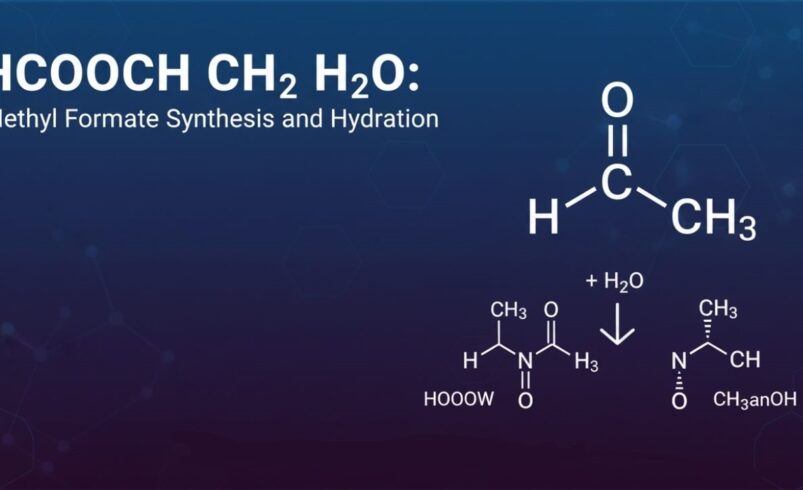Chemistry has the power to unlock the mysteries of the world around us. Many chemical compounds, despite their complexity, are used in everyday applications that make our lives easier, cleaner, and healthier. One such compound, Hcooch Ch2 H2o, is an essential building block in the chemistry of esters and solvents, commonly known as ethyl acetate. Understanding its structure, properties, and real-world applications can open a window to the science behind many industries.
What Is Hcooch Ch2 H2o?
Breaking Down the Formula
The chemical formula Hcooch Ch2 H2o represents a combination of several components. At first glance, it may look complex, but understanding its structure is key to unraveling its significance.
- Hcooch: This stands for an ester group, where a carboxylic acid group reacts with an alcohol group, creating an ester bond.
- Ch2: This is a methylene group (-CH2), part of the carbon backbone in the molecule.
- H2o: This represents a water molecule, crucial in many chemical reactions and processes.
This formula likely refers to ethyl acetate, a commonly used solvent. Ethanol (alcohol) and acetic acid undergo an esterification reaction to form ethyl acetate (Hcooch Ch2 H2o), which finds wide use in multiple industries.
The Role of Water in Esterification
Water plays a pivotal role in the esterification process. In industrial chemistry, the reaction of ethanol with acetic acid often produces water as a byproduct. Excess water can hinder the reaction’s efficiency, so water is often removed to drive the process to completion.
Real-World Applications of Hcooch Ch2 H2o
Ethyl acetate, represented by Hcooch Ch2 H2o, has various practical uses. Let’s explore some of its most notable applications.
Ethyl Acetate in the Paint Industry
Ethyl acetate is a key ingredient in many industrial paints and coatings. It serves as a solvent that dissolves other ingredients in paint, allowing them to be easily applied and dried. Its fast evaporation rate means that surfaces dry quickly, making it ideal for applications where time is a factor.
- Example: Automotive manufacturers often use ethyl acetate to speed up the drying of car paints. This reduces production time and increases efficiency.
Pharmaceutical Industry and Drug Extraction
In the pharmaceutical industry, ethyl acetate is used to extract active pharmaceutical ingredients (APIs) from plants or other raw materials. Its properties as a solvent make it an essential tool in the extraction process. Additionally, it is used to purify and concentrate the active compounds.
- Example: In the extraction of essential oils or herbal extracts, ethyl acetate efficiently isolates valuable compounds without leaving harmful residues.
The Chemistry Behind Ethyl Acetate (Hcooch Ch2 H2o)
How Does Ethyl Acetate Form?
Ethyl acetate is produced through the esterification reaction between acetic acid and ethanol. Reaction typically occurs under acidic conditions, such as with sulfuric acid as a catalyst. This is a reversible reaction:
Ethanol + Acetic Acid → Ethyl Acetate + Water
The presence of water in the reaction can drive the equilibrium backward, meaning water must be removed to produce a higher yield of ethyl acetate.
Esterification Process: Key Insights
- Reversible Reaction: The esterification process is reversible. That means, without careful management of the reaction environment, the reaction can reverse, turning the ethyl acetate back into ethanol and acetic acid.
Advantages and Disadvantages
Advantages of Ethyl Acetate
- Versatility: Ethyl acetate can dissolve a wide range of substances, making it ideal for multiple industries.
- Quick Drying: Its fast evaporation rate is useful in industries like paint and coatings, where rapid drying is essential.
Disadvantages of Ethyl Acetate
- Flammability: Ethyl acetate is highly flammable, posing safety risks in storage and handling.
- Water Sensitivity: In industrial settings, the presence of water can affect the efficiency of the esterification process.
Ethyl Acetate’s Environmental Impact
Green Chemistry and Sustainable Practices
As environmental concerns grow, many industries are looking for more sustainable alternatives to harmful chemicals. Ethyl acetate, despite being a VOC, is considered a “greener” alternative to other solvents such as toluene or xylene. Its lower toxicity and biodegradability make it a safer choice for both humans and the environment.
- Example: In the automotive industry, using ethyl acetate in paints and coatings reduces the release of harmful VOCs into the air compared to using traditional solvents.
Environmental Considerations
While ethyl acetate is less harmful than some other solvents, it still contributes to VOC emissions, which can have adverse effects on air quality. As industries move toward greener solutions, innovations in solvent recycling and waste reduction are helping minimize environmental impact.
The Future of Ethyl Acetate in Industry
Research and Development
Research into improving the production and application of ethyl acetate is ongoing. Researchers explore ways to create more sustainable, cost-effective methods of producing ethyl acetate, such as bio-based routes using renewable resources like ethanol derived from agricultural waste.
Conclusion
The chemical compound Hcooch Ch2 H2o, or ethyl acetate, plays a crucial role in multiple industries, from food flavorings to pharmaceuticals to paints. Understanding its chemical properties and diverse applications helps us appreciate the importance of this seemingly simple molecule. As industries look to create safer, more sustainable solutions, ethyl acetate remains a reliable, eco-friendly choice.
FAQs
Q1: What is Hcooch Ch2 H2o used for?
Hcooch Ch2 H2o is ethyl acetate, a solvent used in paint, pharmaceuticals, food flavorings, and cleaning products.
Q2: How is ethyl acetate produced?
Ethyl acetate is produced by the esterification of ethanol and acetic acid, using an acid catalyst.
Q3: Is ethyl acetate safe?
Ethyl acetate has low toxicity but is flammable and must be handled carefully. It is safe for many consumer products.









